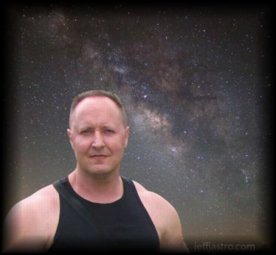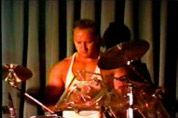
I image from my backyard, and setup/takedown each night I am
out.
![]()
Background: I was born in Germany
(father was stationed overseas) and I currently live in the southwestern United
States. As for my education and career, I have backgrounds in research
meteorology, operations research, and computer science. I have a Master of
Science degree in Engineering (focus on computer modeling and operations
research), as well as a Bachelor's degree in Geography, minor Meteorology.
Following my Master's degree, I was inducted into the Honor
Society of Phi Kappa Phi ![]() .
.
Currently, I work as a research scientist for a large company where my work includes research, analysis and software
development. My hobbies together with astronomy include computer programming,
bodybuilding (me in competition: ![]() ), martial arts, and music.
), martial arts, and music.
I started practicing martial arts (beginning
with Judo) when I was 10 and have trained, sparred, and competed in multiple styles (including
fencing/sword fighting)
since that time. I have specifically practiced JKD since 2002. Favorite
martial artists: Bruce Lee/li xiao long, Matt Hughes. For music, I started playing drums when I was
11, and in high school I was in marching band (snare line), concert band,
stage band (kit), and pep band (kit). I also played in local bands in
many clubs for years with genres spanning alternative rock, rock, and jazz
fusion. Me standing behind my drums:  Favorite drummers: Neil Peart, Billy Cobham, Steve Smith. I have all
of Rush's autographs and one of Neil's sticks. I also met Geddy Lee in person
years ago when I worked a Rush concert as Security/bodyguard - it was absolutely
amazing and a highlight of my life.
Favorite drummers: Neil Peart, Billy Cobham, Steve Smith. I have all
of Rush's autographs and one of Neil's sticks. I also met Geddy Lee in person
years ago when I worked a Rush concert as Security/bodyguard - it was absolutely
amazing and a highlight of my life.
Astronomy Interest: Reading a book that my dad showed me simply
titled "Astronomy" from cover to cover when I was 10, I have a long love of astronomy. Of course, at the time I didn't understand most of it :) For years after, I would just observe the night sky with binoculars or a small telescope that our family had.
My interest was sparked and I studied hard as I knew I wanted to get into
science, taking calculus in high school and advanced math and physics in
college. I did my first "real" astrophotography in 1996, when I used a 35mm SLR camera to take photos of Comet
Hyakutake. Some years later (2003), I bought a 10" dobsonian for viewing, and within a week was taking pictures through the eyepiece for fun. Within a few more weeks, I knew I wanted to get serious with
astronomy, and moved to CCD imaging in 2006. The history of this can be seen starting with the
Solar System area of this site...I then progressed to
Deep Sky Objects (DSO), which is where my primary interest lies. In the
Equipment section of this site, you can see my upgrades throughout this
venture.
Discovery: I have made a discovery of a previously undocumented
emission nebula in the area of M47 on 15 Dec 13. I have details in the notes
area of the M47
result.
Publications: I was thrilled to be published in
(May 2014 issue),
(September 2016, June 2017 issues), as well as having my work featured in Space.com,
YahooNews,
and the Milenio
Newspaper (Monterrey, Mexico), among others.
On the personal side, I am very happily married and living the dream!
Oh, I still have the "Astronomy" book :)
That's enough about me. Hope you enjoy the site, and please feel free to send me an email
(jeffj_alias-astro at yahoo dot
com) if you have any questions or just to say hello.
Best regards,
Jeff Johnson (Jeffrey O. Johnson)
WHAT exactly is the "Bortle Scale" ... and HOW MUCH beauty are you
missing out on?
This image will let you know what "Dark Skies" can mean:
DARK SKIES vs Light Pollution (CLICK)
(Las Cruces is fairly bright 6,7,8 for most of the city)
Bortle
Rating for my location (i.e., my backyard)
| 3 | 6.6 - 7.0 | Rural sky. | MW still appears complex, dark voids and bright patches and meandering outline are all visible. | Brightest Globular Clusters are distinct, but M33 is only visible with averted vision. M31 (the Andromeda Galaxy) is obviously visible. | Zodiacal light is striking in Spring and Autumn, extending 60 degrees above the horizon. |
Airglow is not visible and clouds are faintly illuminated, except at the zenith. |
Some light pollution evident along the horizon. Ground objects are vaguely apparent. |
| 6 | 5.1 - 5.5 | Bright, suburban sky. | MW only apparent overhead and appears broken as fainter parts are lost to sky glow. | M31 is detectable only as a faint smudge; Orion Nebula is seldom glimpsed. | Zodiacal light is not visible. Constellations are seen and not lost against a starry sky. | Clouds anywhere in the sky appear fairly bright as they reflect back light. | Sky from horizon to 35 degrees glows with grayish color. Ground is well lit. |

New Mexico Law for outdoor lighting (since 2000):
http://www.darkskynm.org/lightinglaws.html

Content, Design, and Layout on this site are Copyright © Jeffrey O. Johnson | All rights reserved